Part A Capital Budgeting Answer 2022
VerifiedAdded on 2022/10/15
|10
|2697
|10
AI Summary
Contribute Materials
Your contribution can guide someone’s learning journey. Share your
documents today.
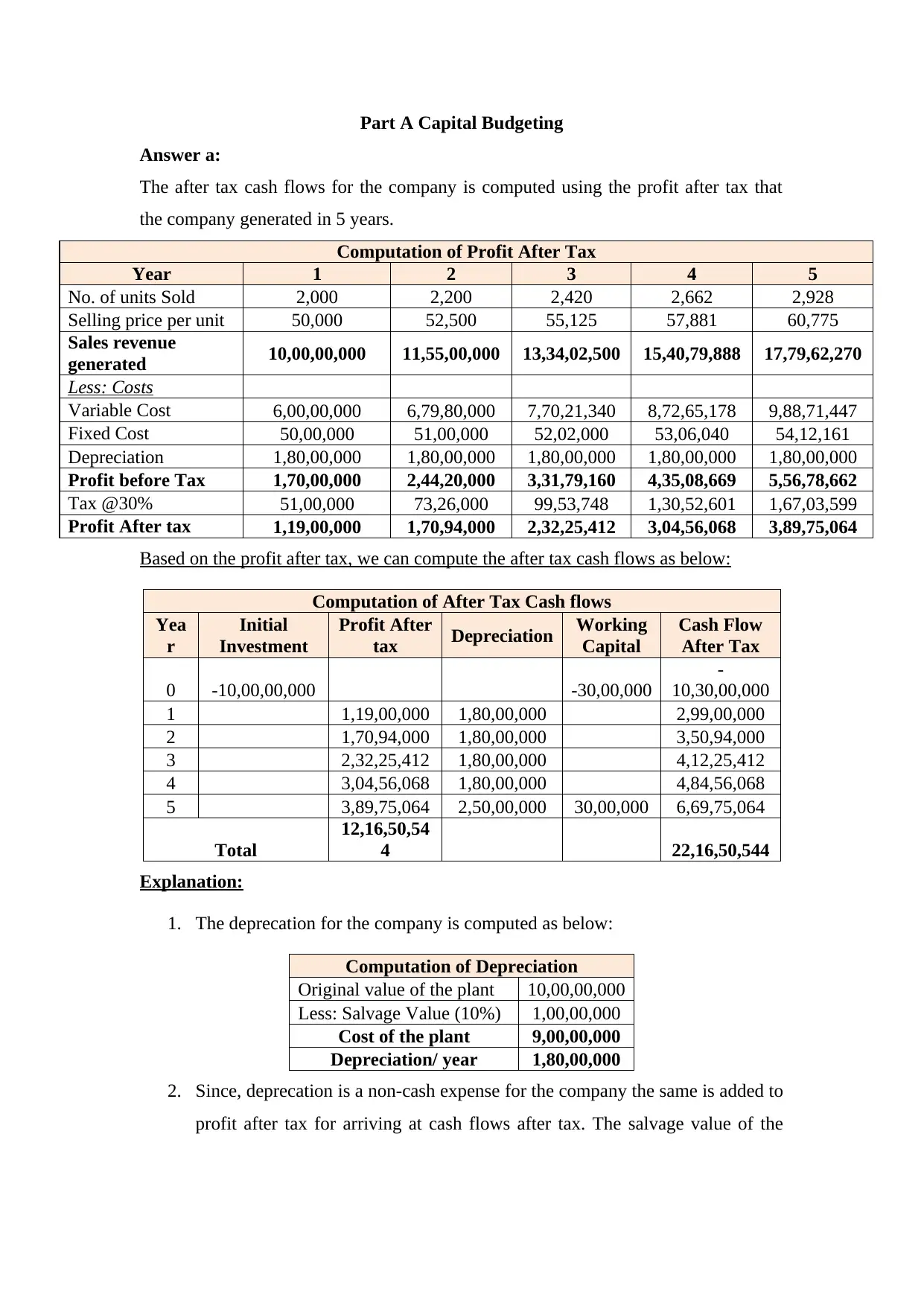
Part A Capital Budgeting
Answer a:
The after tax cash flows for the company is computed using the profit after tax that
the company generated in 5 years.
Computation of Profit After Tax
Year 1 2 3 4 5
No. of units Sold 2,000 2,200 2,420 2,662 2,928
Selling price per unit 50,000 52,500 55,125 57,881 60,775
Sales revenue
generated 10,00,00,000 11,55,00,000 13,34,02,500 15,40,79,888 17,79,62,270
Less: Costs
Variable Cost 6,00,00,000 6,79,80,000 7,70,21,340 8,72,65,178 9,88,71,447
Fixed Cost 50,00,000 51,00,000 52,02,000 53,06,040 54,12,161
Depreciation 1,80,00,000 1,80,00,000 1,80,00,000 1,80,00,000 1,80,00,000
Profit before Tax 1,70,00,000 2,44,20,000 3,31,79,160 4,35,08,669 5,56,78,662
Tax @30% 51,00,000 73,26,000 99,53,748 1,30,52,601 1,67,03,599
Profit After tax 1,19,00,000 1,70,94,000 2,32,25,412 3,04,56,068 3,89,75,064
Based on the profit after tax, we can compute the after tax cash flows as below:
Computation of After Tax Cash flows
Yea
r
Initial
Investment
Profit After
tax Depreciation Working
Capital
Cash Flow
After Tax
0 -10,00,00,000 -30,00,000
-
10,30,00,000
1 1,19,00,000 1,80,00,000 2,99,00,000
2 1,70,94,000 1,80,00,000 3,50,94,000
3 2,32,25,412 1,80,00,000 4,12,25,412
4 3,04,56,068 1,80,00,000 4,84,56,068
5 3,89,75,064 2,50,00,000 30,00,000 6,69,75,064
Total
12,16,50,54
4 22,16,50,544
Explanation:
1. The deprecation for the company is computed as below:
Computation of Depreciation
Original value of the plant 10,00,00,000
Less: Salvage Value (10%) 1,00,00,000
Cost of the plant 9,00,00,000
Depreciation/ year 1,80,00,000
2. Since, deprecation is a non-cash expense for the company the same is added to
profit after tax for arriving at cash flows after tax. The salvage value of the
Answer a:
The after tax cash flows for the company is computed using the profit after tax that
the company generated in 5 years.
Computation of Profit After Tax
Year 1 2 3 4 5
No. of units Sold 2,000 2,200 2,420 2,662 2,928
Selling price per unit 50,000 52,500 55,125 57,881 60,775
Sales revenue
generated 10,00,00,000 11,55,00,000 13,34,02,500 15,40,79,888 17,79,62,270
Less: Costs
Variable Cost 6,00,00,000 6,79,80,000 7,70,21,340 8,72,65,178 9,88,71,447
Fixed Cost 50,00,000 51,00,000 52,02,000 53,06,040 54,12,161
Depreciation 1,80,00,000 1,80,00,000 1,80,00,000 1,80,00,000 1,80,00,000
Profit before Tax 1,70,00,000 2,44,20,000 3,31,79,160 4,35,08,669 5,56,78,662
Tax @30% 51,00,000 73,26,000 99,53,748 1,30,52,601 1,67,03,599
Profit After tax 1,19,00,000 1,70,94,000 2,32,25,412 3,04,56,068 3,89,75,064
Based on the profit after tax, we can compute the after tax cash flows as below:
Computation of After Tax Cash flows
Yea
r
Initial
Investment
Profit After
tax Depreciation Working
Capital
Cash Flow
After Tax
0 -10,00,00,000 -30,00,000
-
10,30,00,000
1 1,19,00,000 1,80,00,000 2,99,00,000
2 1,70,94,000 1,80,00,000 3,50,94,000
3 2,32,25,412 1,80,00,000 4,12,25,412
4 3,04,56,068 1,80,00,000 4,84,56,068
5 3,89,75,064 2,50,00,000 30,00,000 6,69,75,064
Total
12,16,50,54
4 22,16,50,544
Explanation:
1. The deprecation for the company is computed as below:
Computation of Depreciation
Original value of the plant 10,00,00,000
Less: Salvage Value (10%) 1,00,00,000
Cost of the plant 9,00,00,000
Depreciation/ year 1,80,00,000
2. Since, deprecation is a non-cash expense for the company the same is added to
profit after tax for arriving at cash flows after tax. The salvage value of the
Secure Best Marks with AI Grader
Need help grading? Try our AI Grader for instant feedback on your assignments.
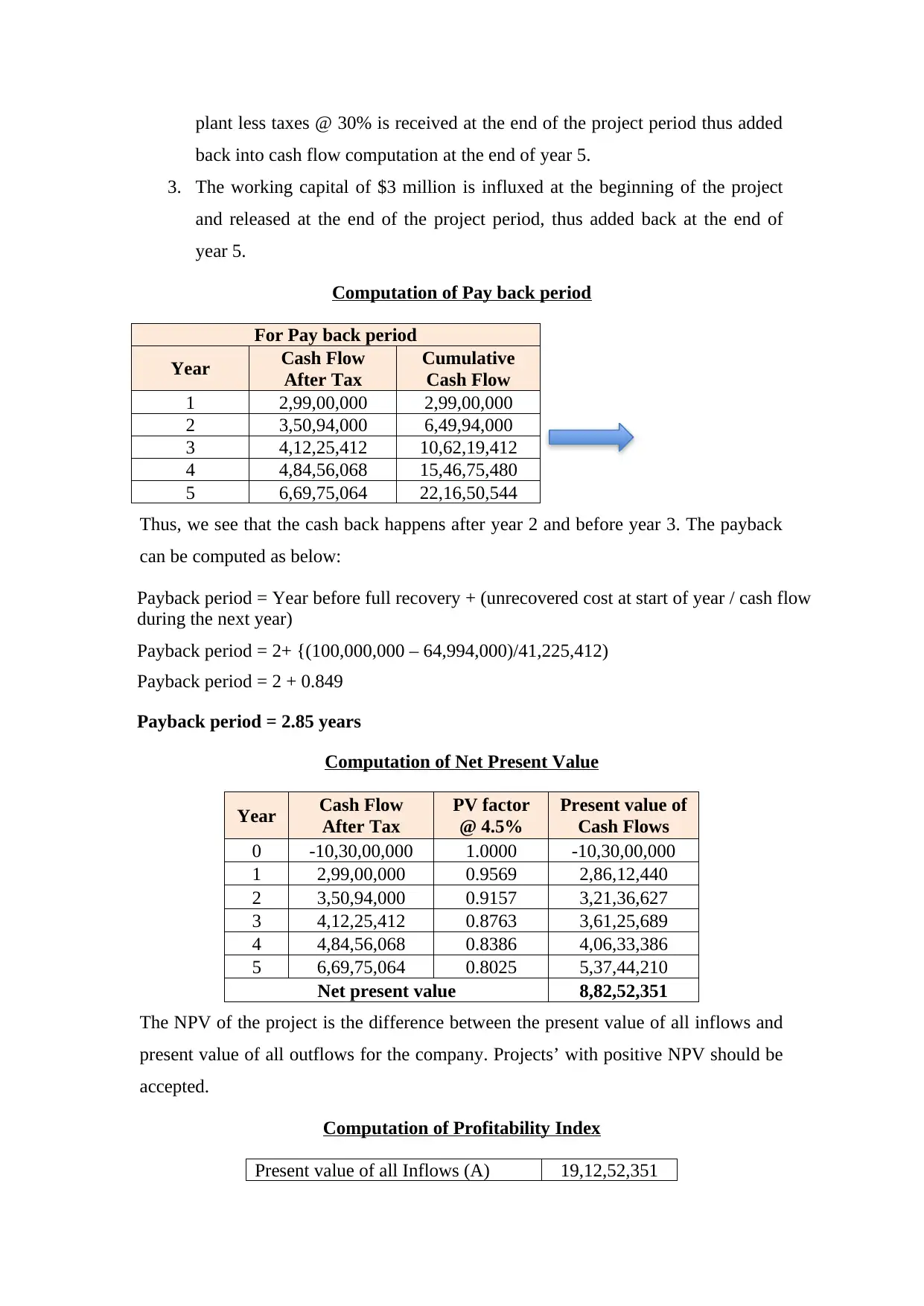
plant less taxes @ 30% is received at the end of the project period thus added
back into cash flow computation at the end of year 5.
3. The working capital of $3 million is influxed at the beginning of the project
and released at the end of the project period, thus added back at the end of
year 5.
Computation of Pay back period
For Pay back period
Year Cash Flow
After Tax
Cumulative
Cash Flow
1 2,99,00,000 2,99,00,000
2 3,50,94,000 6,49,94,000
3 4,12,25,412 10,62,19,412
4 4,84,56,068 15,46,75,480
5 6,69,75,064 22,16,50,544
Thus, we see that the cash back happens after year 2 and before year 3. The payback
can be computed as below:
Payback period = Year before full recovery + (unrecovered cost at start of year / cash flow
during the next year)
Payback period = 2+ {(100,000,000 – 64,994,000)/41,225,412)
Payback period = 2 + 0.849
Payback period = 2.85 years
Computation of Net Present Value
Year Cash Flow
After Tax
PV factor
@ 4.5%
Present value of
Cash Flows
0 -10,30,00,000 1.0000 -10,30,00,000
1 2,99,00,000 0.9569 2,86,12,440
2 3,50,94,000 0.9157 3,21,36,627
3 4,12,25,412 0.8763 3,61,25,689
4 4,84,56,068 0.8386 4,06,33,386
5 6,69,75,064 0.8025 5,37,44,210
Net present value 8,82,52,351
The NPV of the project is the difference between the present value of all inflows and
present value of all outflows for the company. Projects’ with positive NPV should be
accepted.
Computation of Profitability Index
Present value of all Inflows (A) 19,12,52,351
back into cash flow computation at the end of year 5.
3. The working capital of $3 million is influxed at the beginning of the project
and released at the end of the project period, thus added back at the end of
year 5.
Computation of Pay back period
For Pay back period
Year Cash Flow
After Tax
Cumulative
Cash Flow
1 2,99,00,000 2,99,00,000
2 3,50,94,000 6,49,94,000
3 4,12,25,412 10,62,19,412
4 4,84,56,068 15,46,75,480
5 6,69,75,064 22,16,50,544
Thus, we see that the cash back happens after year 2 and before year 3. The payback
can be computed as below:
Payback period = Year before full recovery + (unrecovered cost at start of year / cash flow
during the next year)
Payback period = 2+ {(100,000,000 – 64,994,000)/41,225,412)
Payback period = 2 + 0.849
Payback period = 2.85 years
Computation of Net Present Value
Year Cash Flow
After Tax
PV factor
@ 4.5%
Present value of
Cash Flows
0 -10,30,00,000 1.0000 -10,30,00,000
1 2,99,00,000 0.9569 2,86,12,440
2 3,50,94,000 0.9157 3,21,36,627
3 4,12,25,412 0.8763 3,61,25,689
4 4,84,56,068 0.8386 4,06,33,386
5 6,69,75,064 0.8025 5,37,44,210
Net present value 8,82,52,351
The NPV of the project is the difference between the present value of all inflows and
present value of all outflows for the company. Projects’ with positive NPV should be
accepted.
Computation of Profitability Index
Present value of all Inflows (A) 19,12,52,351
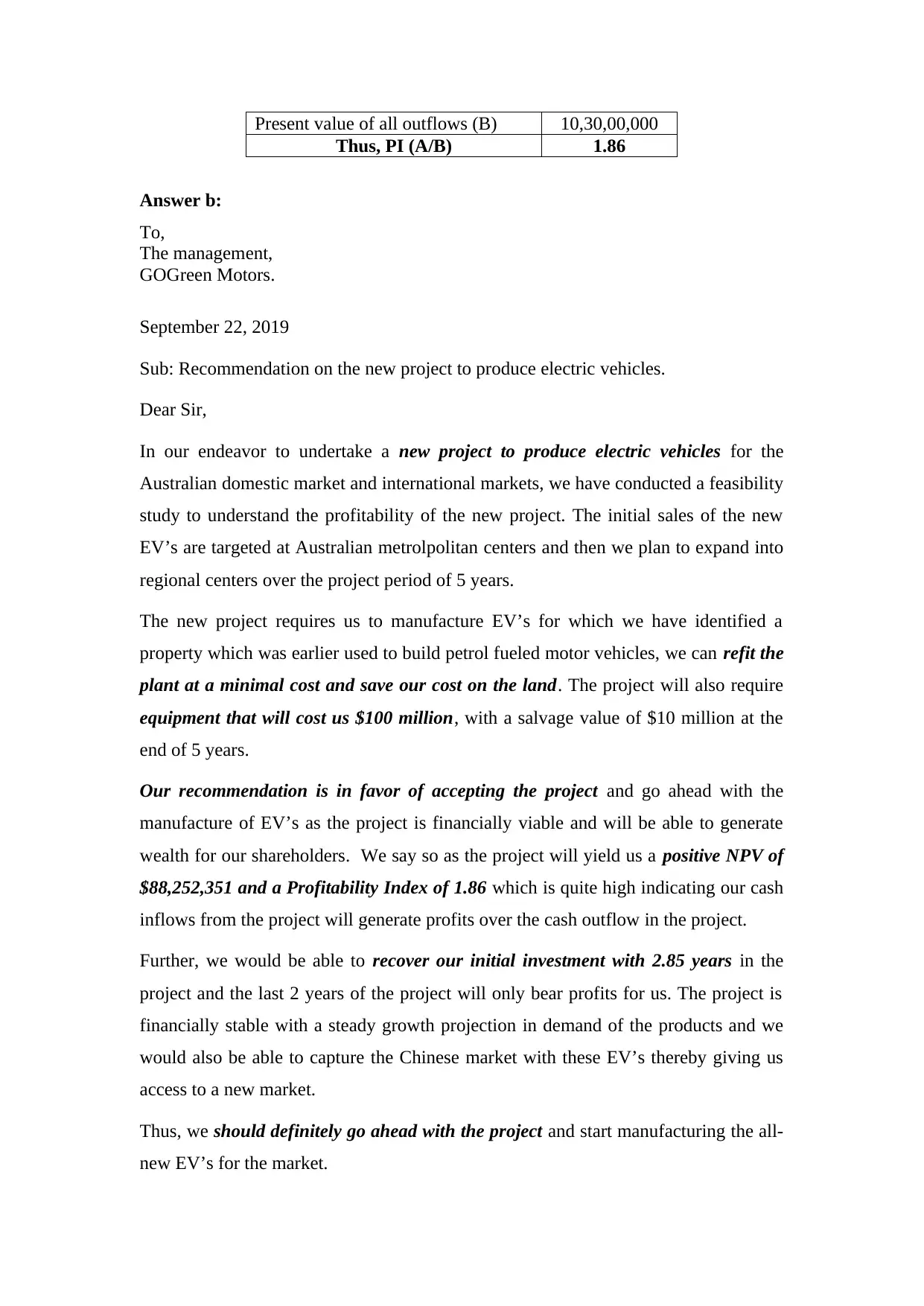
Present value of all outflows (B) 10,30,00,000
Thus, PI (A/B) 1.86
Answer b:
To,
The management,
GOGreen Motors.
September 22, 2019
Sub: Recommendation on the new project to produce electric vehicles.
Dear Sir,
In our endeavor to undertake a new project to produce electric vehicles for the
Australian domestic market and international markets, we have conducted a feasibility
study to understand the profitability of the new project. The initial sales of the new
EV’s are targeted at Australian metrolpolitan centers and then we plan to expand into
regional centers over the project period of 5 years.
The new project requires us to manufacture EV’s for which we have identified a
property which was earlier used to build petrol fueled motor vehicles, we can refit the
plant at a minimal cost and save our cost on the land. The project will also require
equipment that will cost us $100 million, with a salvage value of $10 million at the
end of 5 years.
Our recommendation is in favor of accepting the project and go ahead with the
manufacture of EV’s as the project is financially viable and will be able to generate
wealth for our shareholders. We say so as the project will yield us a positive NPV of
$88,252,351 and a Profitability Index of 1.86 which is quite high indicating our cash
inflows from the project will generate profits over the cash outflow in the project.
Further, we would be able to recover our initial investment with 2.85 years in the
project and the last 2 years of the project will only bear profits for us. The project is
financially stable with a steady growth projection in demand of the products and we
would also be able to capture the Chinese market with these EV’s thereby giving us
access to a new market.
Thus, we should definitely go ahead with the project and start manufacturing the all-
new EV’s for the market.
Thus, PI (A/B) 1.86
Answer b:
To,
The management,
GOGreen Motors.
September 22, 2019
Sub: Recommendation on the new project to produce electric vehicles.
Dear Sir,
In our endeavor to undertake a new project to produce electric vehicles for the
Australian domestic market and international markets, we have conducted a feasibility
study to understand the profitability of the new project. The initial sales of the new
EV’s are targeted at Australian metrolpolitan centers and then we plan to expand into
regional centers over the project period of 5 years.
The new project requires us to manufacture EV’s for which we have identified a
property which was earlier used to build petrol fueled motor vehicles, we can refit the
plant at a minimal cost and save our cost on the land. The project will also require
equipment that will cost us $100 million, with a salvage value of $10 million at the
end of 5 years.
Our recommendation is in favor of accepting the project and go ahead with the
manufacture of EV’s as the project is financially viable and will be able to generate
wealth for our shareholders. We say so as the project will yield us a positive NPV of
$88,252,351 and a Profitability Index of 1.86 which is quite high indicating our cash
inflows from the project will generate profits over the cash outflow in the project.
Further, we would be able to recover our initial investment with 2.85 years in the
project and the last 2 years of the project will only bear profits for us. The project is
financially stable with a steady growth projection in demand of the products and we
would also be able to capture the Chinese market with these EV’s thereby giving us
access to a new market.
Thus, we should definitely go ahead with the project and start manufacturing the all-
new EV’s for the market.
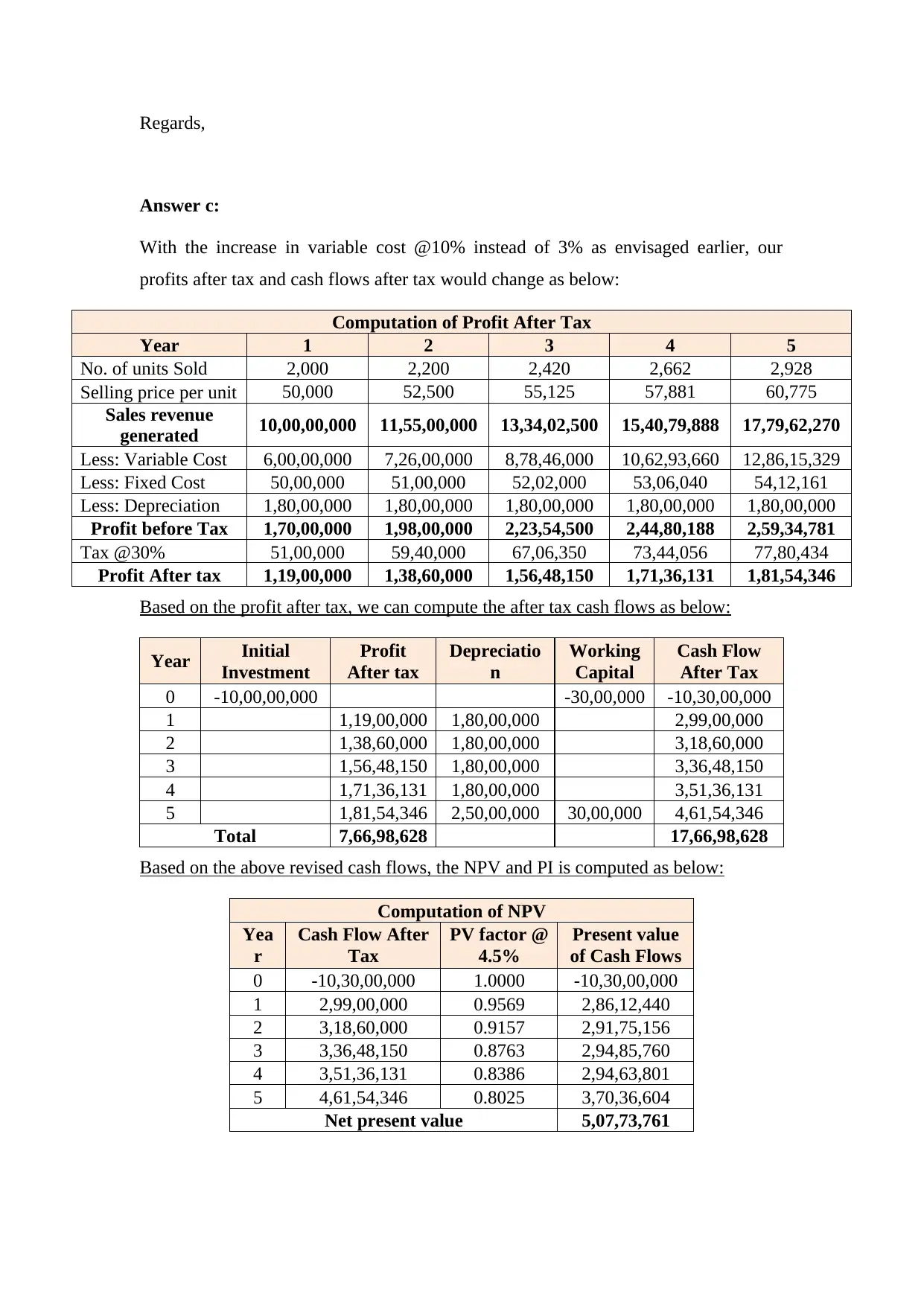
Regards,
Answer c:
With the increase in variable cost @10% instead of 3% as envisaged earlier, our
profits after tax and cash flows after tax would change as below:
Computation of Profit After Tax
Year 1 2 3 4 5
No. of units Sold 2,000 2,200 2,420 2,662 2,928
Selling price per unit 50,000 52,500 55,125 57,881 60,775
Sales revenue
generated 10,00,00,000 11,55,00,000 13,34,02,500 15,40,79,888 17,79,62,270
Less: Variable Cost 6,00,00,000 7,26,00,000 8,78,46,000 10,62,93,660 12,86,15,329
Less: Fixed Cost 50,00,000 51,00,000 52,02,000 53,06,040 54,12,161
Less: Depreciation 1,80,00,000 1,80,00,000 1,80,00,000 1,80,00,000 1,80,00,000
Profit before Tax 1,70,00,000 1,98,00,000 2,23,54,500 2,44,80,188 2,59,34,781
Tax @30% 51,00,000 59,40,000 67,06,350 73,44,056 77,80,434
Profit After tax 1,19,00,000 1,38,60,000 1,56,48,150 1,71,36,131 1,81,54,346
Based on the profit after tax, we can compute the after tax cash flows as below:
Year Initial
Investment
Profit
After tax
Depreciatio
n
Working
Capital
Cash Flow
After Tax
0 -10,00,00,000 -30,00,000 -10,30,00,000
1 1,19,00,000 1,80,00,000 2,99,00,000
2 1,38,60,000 1,80,00,000 3,18,60,000
3 1,56,48,150 1,80,00,000 3,36,48,150
4 1,71,36,131 1,80,00,000 3,51,36,131
5 1,81,54,346 2,50,00,000 30,00,000 4,61,54,346
Total 7,66,98,628 17,66,98,628
Based on the above revised cash flows, the NPV and PI is computed as below:
Computation of NPV
Yea
r
Cash Flow After
Tax
PV factor @
4.5%
Present value
of Cash Flows
0 -10,30,00,000 1.0000 -10,30,00,000
1 2,99,00,000 0.9569 2,86,12,440
2 3,18,60,000 0.9157 2,91,75,156
3 3,36,48,150 0.8763 2,94,85,760
4 3,51,36,131 0.8386 2,94,63,801
5 4,61,54,346 0.8025 3,70,36,604
Net present value 5,07,73,761
Answer c:
With the increase in variable cost @10% instead of 3% as envisaged earlier, our
profits after tax and cash flows after tax would change as below:
Computation of Profit After Tax
Year 1 2 3 4 5
No. of units Sold 2,000 2,200 2,420 2,662 2,928
Selling price per unit 50,000 52,500 55,125 57,881 60,775
Sales revenue
generated 10,00,00,000 11,55,00,000 13,34,02,500 15,40,79,888 17,79,62,270
Less: Variable Cost 6,00,00,000 7,26,00,000 8,78,46,000 10,62,93,660 12,86,15,329
Less: Fixed Cost 50,00,000 51,00,000 52,02,000 53,06,040 54,12,161
Less: Depreciation 1,80,00,000 1,80,00,000 1,80,00,000 1,80,00,000 1,80,00,000
Profit before Tax 1,70,00,000 1,98,00,000 2,23,54,500 2,44,80,188 2,59,34,781
Tax @30% 51,00,000 59,40,000 67,06,350 73,44,056 77,80,434
Profit After tax 1,19,00,000 1,38,60,000 1,56,48,150 1,71,36,131 1,81,54,346
Based on the profit after tax, we can compute the after tax cash flows as below:
Year Initial
Investment
Profit
After tax
Depreciatio
n
Working
Capital
Cash Flow
After Tax
0 -10,00,00,000 -30,00,000 -10,30,00,000
1 1,19,00,000 1,80,00,000 2,99,00,000
2 1,38,60,000 1,80,00,000 3,18,60,000
3 1,56,48,150 1,80,00,000 3,36,48,150
4 1,71,36,131 1,80,00,000 3,51,36,131
5 1,81,54,346 2,50,00,000 30,00,000 4,61,54,346
Total 7,66,98,628 17,66,98,628
Based on the above revised cash flows, the NPV and PI is computed as below:
Computation of NPV
Yea
r
Cash Flow After
Tax
PV factor @
4.5%
Present value
of Cash Flows
0 -10,30,00,000 1.0000 -10,30,00,000
1 2,99,00,000 0.9569 2,86,12,440
2 3,18,60,000 0.9157 2,91,75,156
3 3,36,48,150 0.8763 2,94,85,760
4 3,51,36,131 0.8386 2,94,63,801
5 4,61,54,346 0.8025 3,70,36,604
Net present value 5,07,73,761
Secure Best Marks with AI Grader
Need help grading? Try our AI Grader for instant feedback on your assignments.
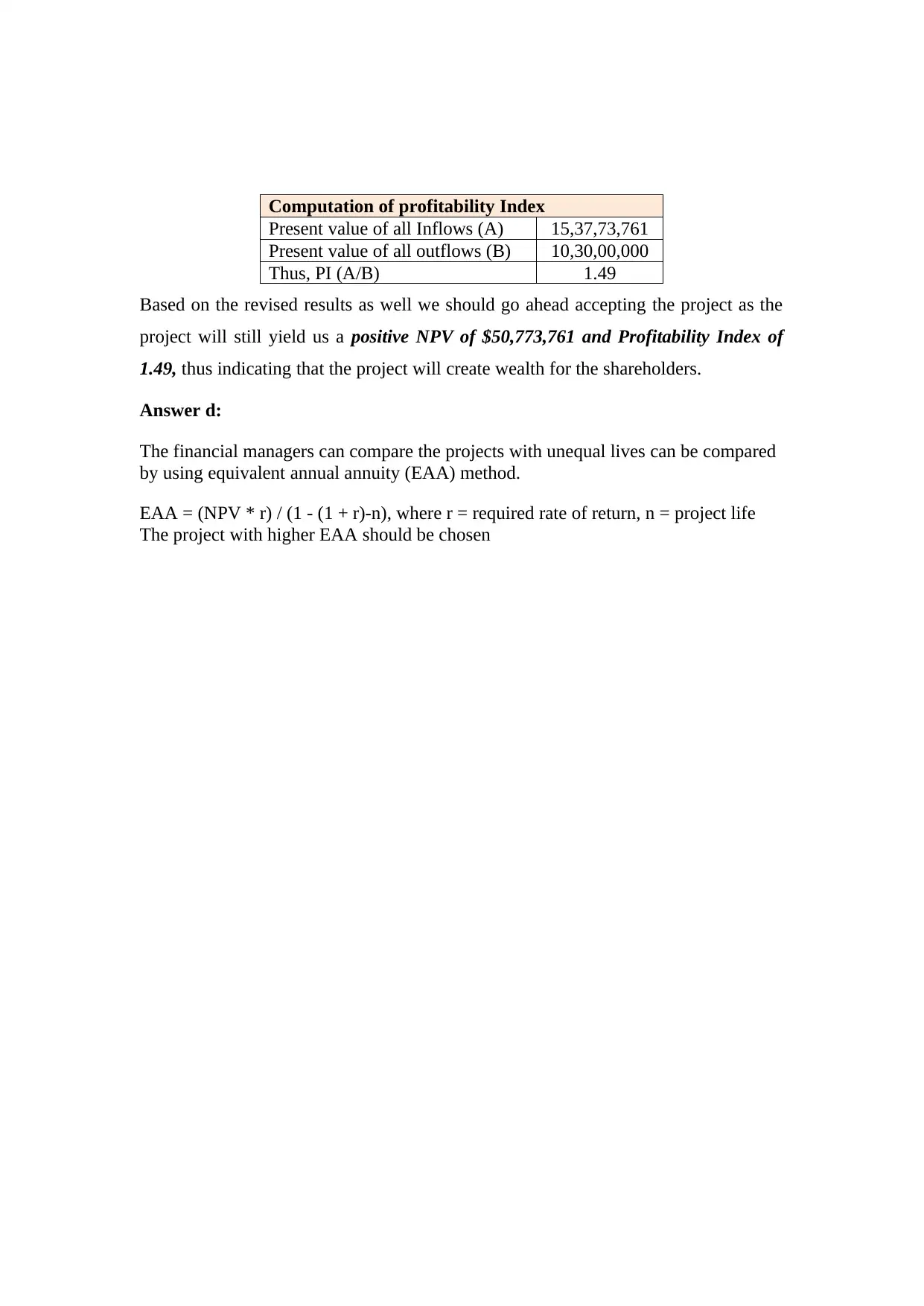
Computation of profitability Index
Present value of all Inflows (A) 15,37,73,761
Present value of all outflows (B) 10,30,00,000
Thus, PI (A/B) 1.49
Based on the revised results as well we should go ahead accepting the project as the
project will still yield us a positive NPV of $50,773,761 and Profitability Index of
1.49, thus indicating that the project will create wealth for the shareholders.
Answer d:
The financial managers can compare the projects with unequal lives can be compared
by using equivalent annual annuity (EAA) method.
EAA = (NPV * r) / (1 - (1 + r)-n), where r = required rate of return, n = project life
The project with higher EAA should be chosen
Present value of all Inflows (A) 15,37,73,761
Present value of all outflows (B) 10,30,00,000
Thus, PI (A/B) 1.49
Based on the revised results as well we should go ahead accepting the project as the
project will still yield us a positive NPV of $50,773,761 and Profitability Index of
1.49, thus indicating that the project will create wealth for the shareholders.
Answer d:
The financial managers can compare the projects with unequal lives can be compared
by using equivalent annual annuity (EAA) method.
EAA = (NPV * r) / (1 - (1 + r)-n), where r = required rate of return, n = project life
The project with higher EAA should be chosen
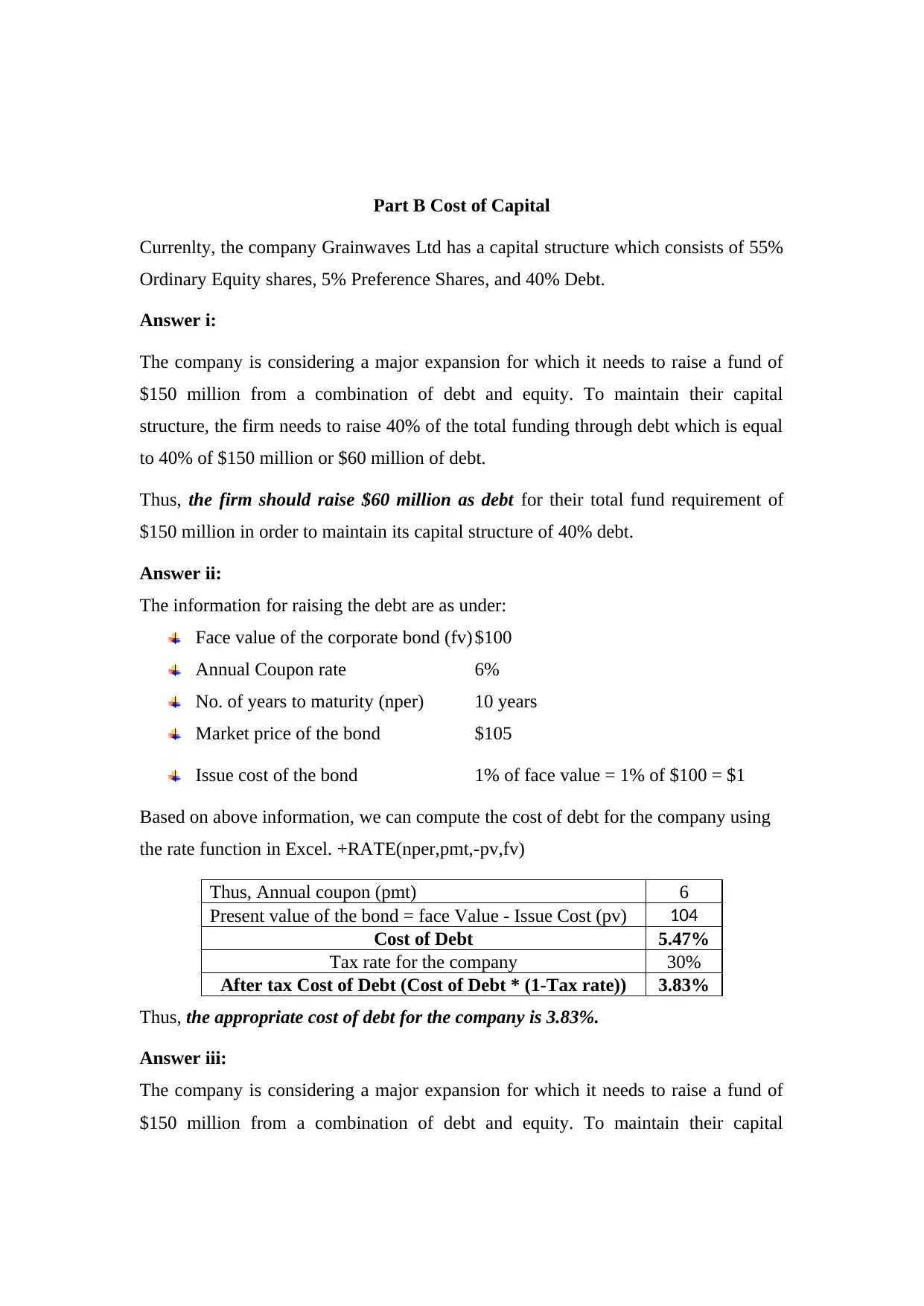
Part B Cost of Capital
Currenlty, the company Grainwaves Ltd has a capital structure which consists of 55%
Ordinary Equity shares, 5% Preference Shares, and 40% Debt.
Answer i:
The company is considering a major expansion for which it needs to raise a fund of
$150 million from a combination of debt and equity. To maintain their capital
structure, the firm needs to raise 40% of the total funding through debt which is equal
to 40% of $150 million or $60 million of debt.
Thus, the firm should raise $60 million as debt for their total fund requirement of
$150 million in order to maintain its capital structure of 40% debt.
Answer ii:
The information for raising the debt are as under:
Face value of the corporate bond (fv) $100
Annual Coupon rate 6%
No. of years to maturity (nper) 10 years
Market price of the bond $105
Issue cost of the bond 1% of face value = 1% of $100 = $1
Based on above information, we can compute the cost of debt for the company using
the rate function in Excel. +RATE(nper,pmt,-pv,fv)
Thus, Annual coupon (pmt) 6
Present value of the bond = face Value - Issue Cost (pv) 104
Cost of Debt 5.47%
Tax rate for the company 30%
After tax Cost of Debt (Cost of Debt * (1-Tax rate)) 3.83%
Thus, the appropriate cost of debt for the company is 3.83%.
Answer iii:
The company is considering a major expansion for which it needs to raise a fund of
$150 million from a combination of debt and equity. To maintain their capital
Currenlty, the company Grainwaves Ltd has a capital structure which consists of 55%
Ordinary Equity shares, 5% Preference Shares, and 40% Debt.
Answer i:
The company is considering a major expansion for which it needs to raise a fund of
$150 million from a combination of debt and equity. To maintain their capital
structure, the firm needs to raise 40% of the total funding through debt which is equal
to 40% of $150 million or $60 million of debt.
Thus, the firm should raise $60 million as debt for their total fund requirement of
$150 million in order to maintain its capital structure of 40% debt.
Answer ii:
The information for raising the debt are as under:
Face value of the corporate bond (fv) $100
Annual Coupon rate 6%
No. of years to maturity (nper) 10 years
Market price of the bond $105
Issue cost of the bond 1% of face value = 1% of $100 = $1
Based on above information, we can compute the cost of debt for the company using
the rate function in Excel. +RATE(nper,pmt,-pv,fv)
Thus, Annual coupon (pmt) 6
Present value of the bond = face Value - Issue Cost (pv) 104
Cost of Debt 5.47%
Tax rate for the company 30%
After tax Cost of Debt (Cost of Debt * (1-Tax rate)) 3.83%
Thus, the appropriate cost of debt for the company is 3.83%.
Answer iii:
The company is considering a major expansion for which it needs to raise a fund of
$150 million from a combination of debt and equity. To maintain their capital
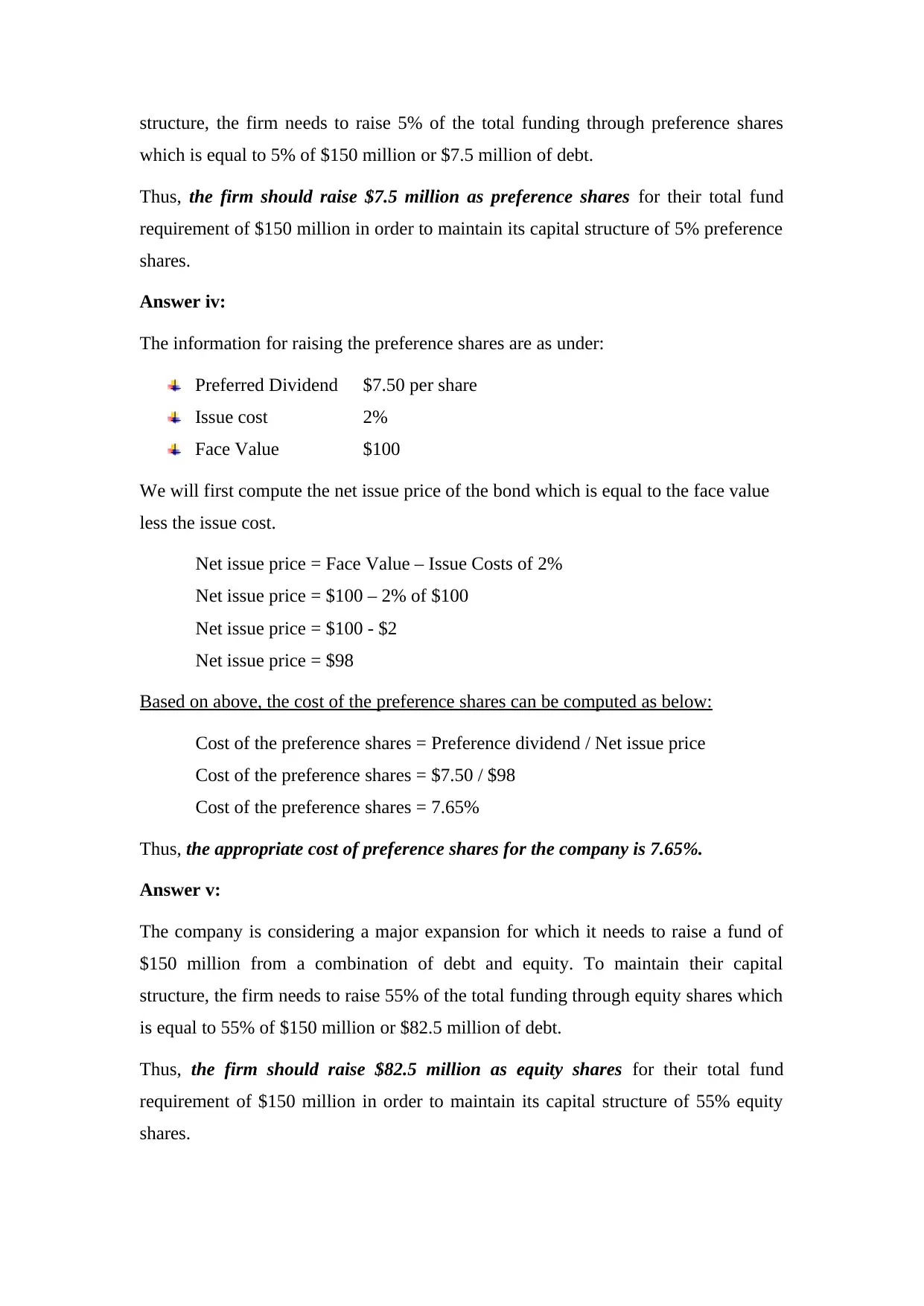
structure, the firm needs to raise 5% of the total funding through preference shares
which is equal to 5% of $150 million or $7.5 million of debt.
Thus, the firm should raise $7.5 million as preference shares for their total fund
requirement of $150 million in order to maintain its capital structure of 5% preference
shares.
Answer iv:
The information for raising the preference shares are as under:
Preferred Dividend $7.50 per share
Issue cost 2%
Face Value $100
We will first compute the net issue price of the bond which is equal to the face value
less the issue cost.
Net issue price = Face Value – Issue Costs of 2%
Net issue price = $100 – 2% of $100
Net issue price = $100 - $2
Net issue price = $98
Based on above, the cost of the preference shares can be computed as below:
Cost of the preference shares = Preference dividend / Net issue price
Cost of the preference shares = $7.50 / $98
Cost of the preference shares = 7.65%
Thus, the appropriate cost of preference shares for the company is 7.65%.
Answer v:
The company is considering a major expansion for which it needs to raise a fund of
$150 million from a combination of debt and equity. To maintain their capital
structure, the firm needs to raise 55% of the total funding through equity shares which
is equal to 55% of $150 million or $82.5 million of debt.
Thus, the firm should raise $82.5 million as equity shares for their total fund
requirement of $150 million in order to maintain its capital structure of 55% equity
shares.
which is equal to 5% of $150 million or $7.5 million of debt.
Thus, the firm should raise $7.5 million as preference shares for their total fund
requirement of $150 million in order to maintain its capital structure of 5% preference
shares.
Answer iv:
The information for raising the preference shares are as under:
Preferred Dividend $7.50 per share
Issue cost 2%
Face Value $100
We will first compute the net issue price of the bond which is equal to the face value
less the issue cost.
Net issue price = Face Value – Issue Costs of 2%
Net issue price = $100 – 2% of $100
Net issue price = $100 - $2
Net issue price = $98
Based on above, the cost of the preference shares can be computed as below:
Cost of the preference shares = Preference dividend / Net issue price
Cost of the preference shares = $7.50 / $98
Cost of the preference shares = 7.65%
Thus, the appropriate cost of preference shares for the company is 7.65%.
Answer v:
The company is considering a major expansion for which it needs to raise a fund of
$150 million from a combination of debt and equity. To maintain their capital
structure, the firm needs to raise 55% of the total funding through equity shares which
is equal to 55% of $150 million or $82.5 million of debt.
Thus, the firm should raise $82.5 million as equity shares for their total fund
requirement of $150 million in order to maintain its capital structure of 55% equity
shares.
Paraphrase This Document
Need a fresh take? Get an instant paraphrase of this document with our AI Paraphraser
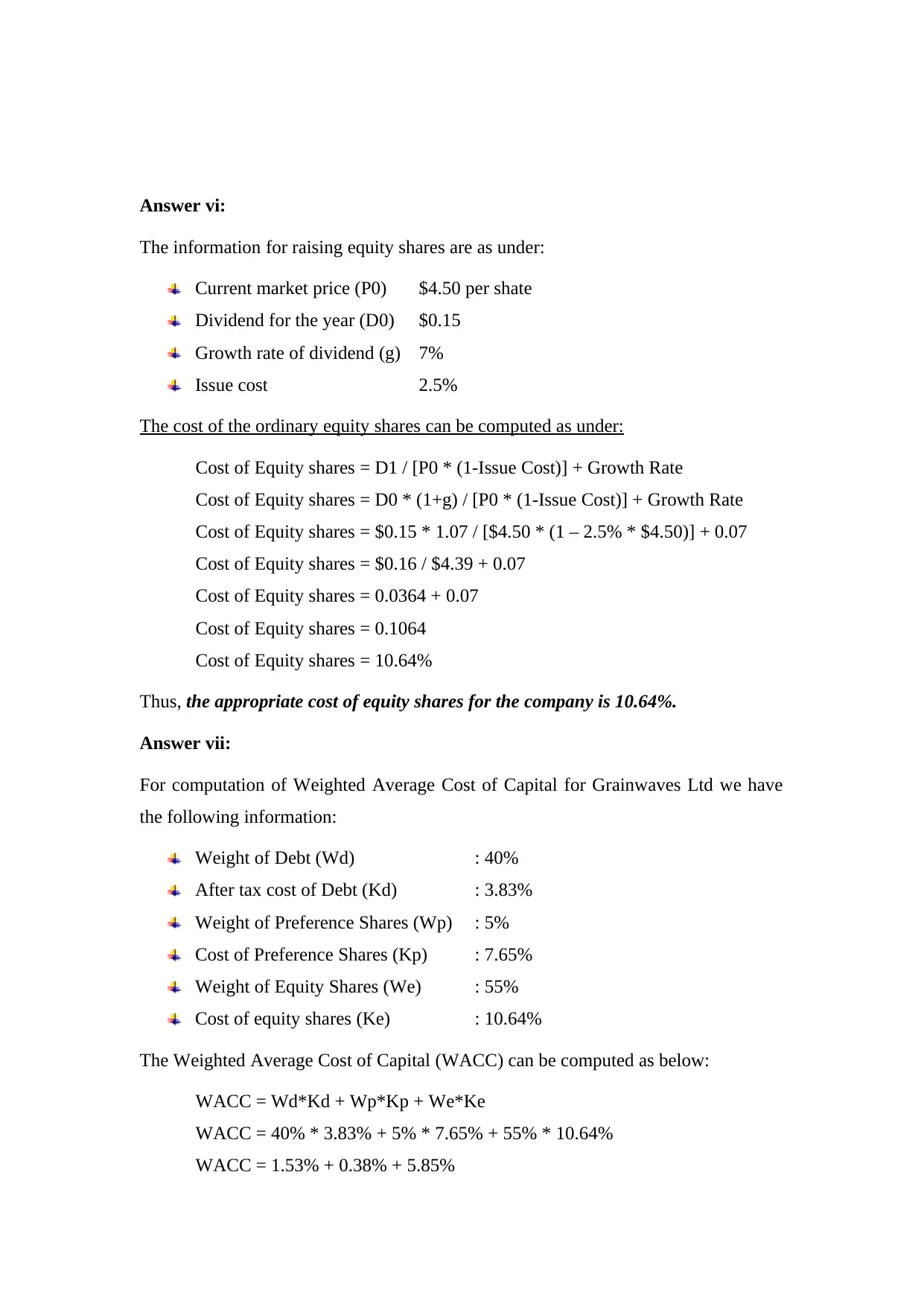
Answer vi:
The information for raising equity shares are as under:
Current market price (P0) $4.50 per shate
Dividend for the year (D0) $0.15
Growth rate of dividend (g) 7%
Issue cost 2.5%
The cost of the ordinary equity shares can be computed as under:
Cost of Equity shares = D1 / [P0 * (1-Issue Cost)] + Growth Rate
Cost of Equity shares = D0 * (1+g) / [P0 * (1-Issue Cost)] + Growth Rate
Cost of Equity shares = $0.15 * 1.07 / [$4.50 * (1 – 2.5% * $4.50)] + 0.07
Cost of Equity shares = $0.16 / $4.39 + 0.07
Cost of Equity shares = 0.0364 + 0.07
Cost of Equity shares = 0.1064
Cost of Equity shares = 10.64%
Thus, the appropriate cost of equity shares for the company is 10.64%.
Answer vii:
For computation of Weighted Average Cost of Capital for Grainwaves Ltd we have
the following information:
Weight of Debt (Wd) : 40%
After tax cost of Debt (Kd) : 3.83%
Weight of Preference Shares (Wp) : 5%
Cost of Preference Shares (Kp) : 7.65%
Weight of Equity Shares (We) : 55%
Cost of equity shares (Ke) : 10.64%
The Weighted Average Cost of Capital (WACC) can be computed as below:
WACC = Wd*Kd + Wp*Kp + We*Ke
WACC = 40% * 3.83% + 5% * 7.65% + 55% * 10.64%
WACC = 1.53% + 0.38% + 5.85%
The information for raising equity shares are as under:
Current market price (P0) $4.50 per shate
Dividend for the year (D0) $0.15
Growth rate of dividend (g) 7%
Issue cost 2.5%
The cost of the ordinary equity shares can be computed as under:
Cost of Equity shares = D1 / [P0 * (1-Issue Cost)] + Growth Rate
Cost of Equity shares = D0 * (1+g) / [P0 * (1-Issue Cost)] + Growth Rate
Cost of Equity shares = $0.15 * 1.07 / [$4.50 * (1 – 2.5% * $4.50)] + 0.07
Cost of Equity shares = $0.16 / $4.39 + 0.07
Cost of Equity shares = 0.0364 + 0.07
Cost of Equity shares = 0.1064
Cost of Equity shares = 10.64%
Thus, the appropriate cost of equity shares for the company is 10.64%.
Answer vii:
For computation of Weighted Average Cost of Capital for Grainwaves Ltd we have
the following information:
Weight of Debt (Wd) : 40%
After tax cost of Debt (Kd) : 3.83%
Weight of Preference Shares (Wp) : 5%
Cost of Preference Shares (Kp) : 7.65%
Weight of Equity Shares (We) : 55%
Cost of equity shares (Ke) : 10.64%
The Weighted Average Cost of Capital (WACC) can be computed as below:
WACC = Wd*Kd + Wp*Kp + We*Ke
WACC = 40% * 3.83% + 5% * 7.65% + 55% * 10.64%
WACC = 1.53% + 0.38% + 5.85%
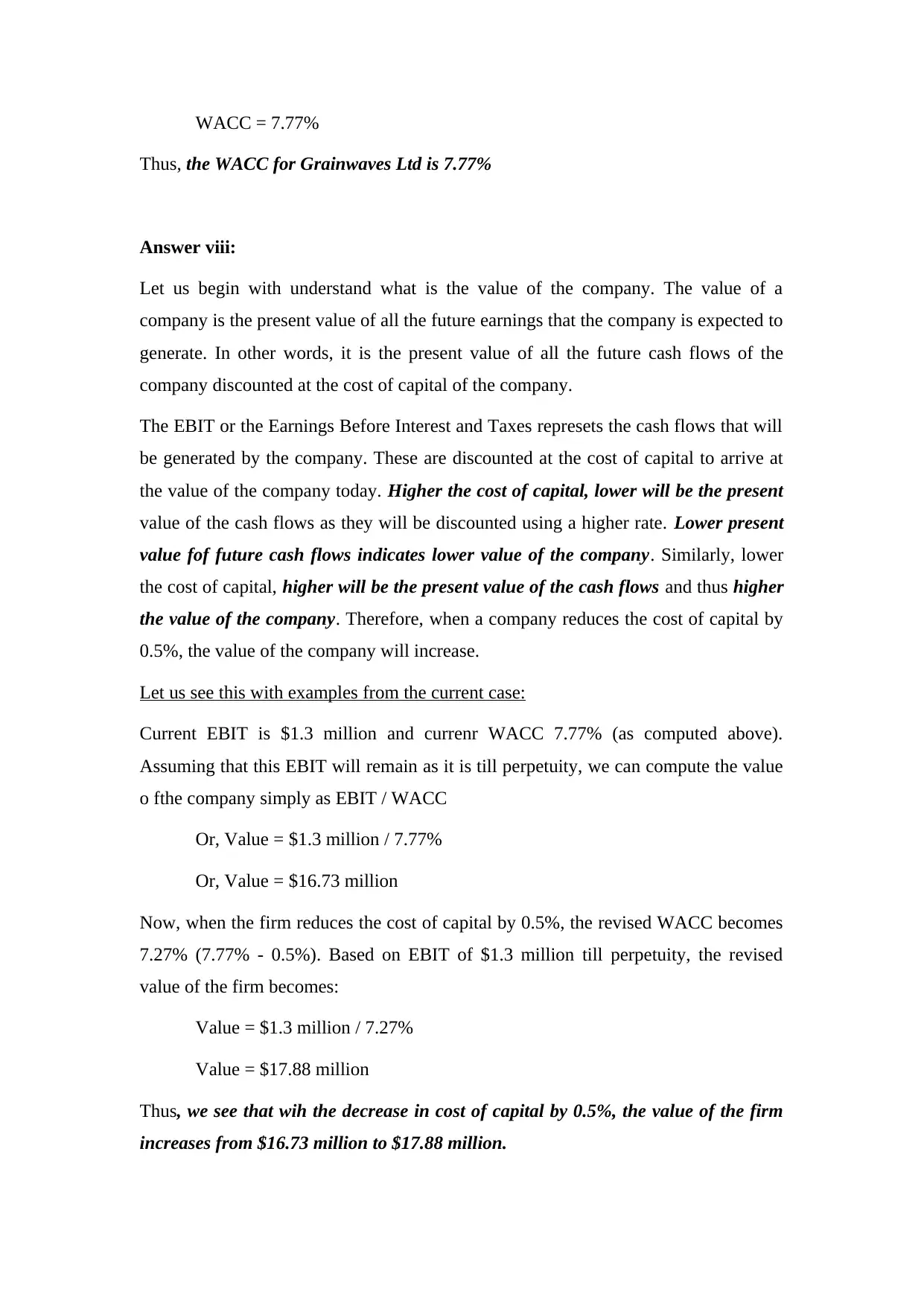
WACC = 7.77%
Thus, the WACC for Grainwaves Ltd is 7.77%
Answer viii:
Let us begin with understand what is the value of the company. The value of a
company is the present value of all the future earnings that the company is expected to
generate. In other words, it is the present value of all the future cash flows of the
company discounted at the cost of capital of the company.
The EBIT or the Earnings Before Interest and Taxes represets the cash flows that will
be generated by the company. These are discounted at the cost of capital to arrive at
the value of the company today. Higher the cost of capital, lower will be the present
value of the cash flows as they will be discounted using a higher rate. Lower present
value fof future cash flows indicates lower value of the company. Similarly, lower
the cost of capital, higher will be the present value of the cash flows and thus higher
the value of the company. Therefore, when a company reduces the cost of capital by
0.5%, the value of the company will increase.
Let us see this with examples from the current case:
Current EBIT is $1.3 million and currenr WACC 7.77% (as computed above).
Assuming that this EBIT will remain as it is till perpetuity, we can compute the value
o fthe company simply as EBIT / WACC
Or, Value = $1.3 million / 7.77%
Or, Value = $16.73 million
Now, when the firm reduces the cost of capital by 0.5%, the revised WACC becomes
7.27% (7.77% - 0.5%). Based on EBIT of $1.3 million till perpetuity, the revised
value of the firm becomes:
Value = $1.3 million / 7.27%
Value = $17.88 million
Thus, we see that wih the decrease in cost of capital by 0.5%, the value of the firm
increases from $16.73 million to $17.88 million.
Thus, the WACC for Grainwaves Ltd is 7.77%
Answer viii:
Let us begin with understand what is the value of the company. The value of a
company is the present value of all the future earnings that the company is expected to
generate. In other words, it is the present value of all the future cash flows of the
company discounted at the cost of capital of the company.
The EBIT or the Earnings Before Interest and Taxes represets the cash flows that will
be generated by the company. These are discounted at the cost of capital to arrive at
the value of the company today. Higher the cost of capital, lower will be the present
value of the cash flows as they will be discounted using a higher rate. Lower present
value fof future cash flows indicates lower value of the company. Similarly, lower
the cost of capital, higher will be the present value of the cash flows and thus higher
the value of the company. Therefore, when a company reduces the cost of capital by
0.5%, the value of the company will increase.
Let us see this with examples from the current case:
Current EBIT is $1.3 million and currenr WACC 7.77% (as computed above).
Assuming that this EBIT will remain as it is till perpetuity, we can compute the value
o fthe company simply as EBIT / WACC
Or, Value = $1.3 million / 7.77%
Or, Value = $16.73 million
Now, when the firm reduces the cost of capital by 0.5%, the revised WACC becomes
7.27% (7.77% - 0.5%). Based on EBIT of $1.3 million till perpetuity, the revised
value of the firm becomes:
Value = $1.3 million / 7.27%
Value = $17.88 million
Thus, we see that wih the decrease in cost of capital by 0.5%, the value of the firm
increases from $16.73 million to $17.88 million.
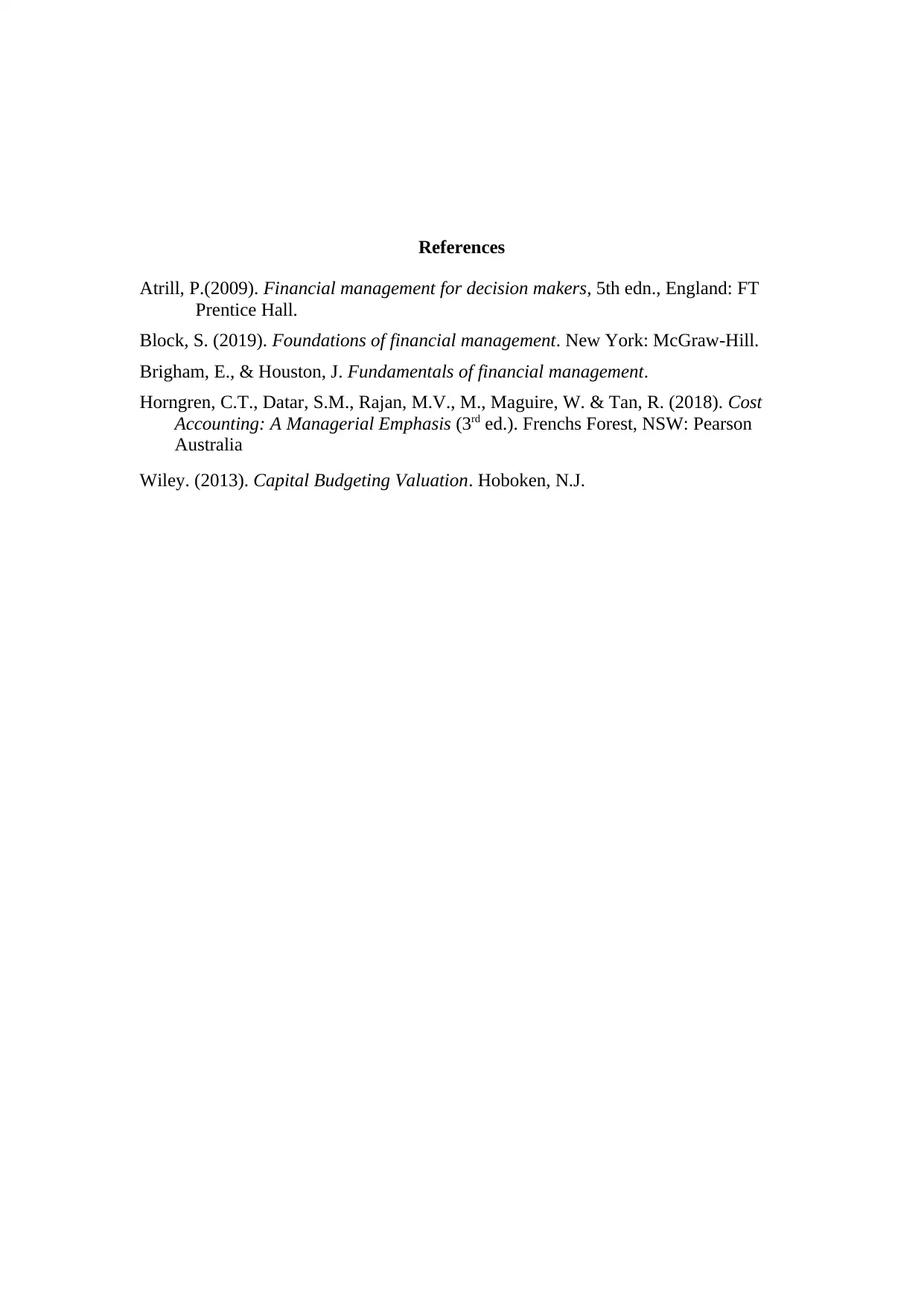
References
Atrill, P.(2009). Financial management for decision makers, 5th edn., England: FT
Prentice Hall.
Block, S. (2019). Foundations of financial management. New York: McGraw-Hill.
Brigham, E., & Houston, J. Fundamentals of financial management.
Horngren, C.T., Datar, S.M., Rajan, M.V., M., Maguire, W. & Tan, R. (2018). Cost
Accounting: A Managerial Emphasis (3rd ed.). Frenchs Forest, NSW: Pearson
Australia
Wiley. (2013). Capital Budgeting Valuation. Hoboken, N.J.
Atrill, P.(2009). Financial management for decision makers, 5th edn., England: FT
Prentice Hall.
Block, S. (2019). Foundations of financial management. New York: McGraw-Hill.
Brigham, E., & Houston, J. Fundamentals of financial management.
Horngren, C.T., Datar, S.M., Rajan, M.V., M., Maguire, W. & Tan, R. (2018). Cost
Accounting: A Managerial Emphasis (3rd ed.). Frenchs Forest, NSW: Pearson
Australia
Wiley. (2013). Capital Budgeting Valuation. Hoboken, N.J.
1 out of 10
Related Documents
Your All-in-One AI-Powered Toolkit for Academic Success.
+13062052269
info@desklib.com
Available 24*7 on WhatsApp / Email
![[object Object]](/_next/static/media/star-bottom.7253800d.svg)
Unlock your academic potential
© 2024 | Zucol Services PVT LTD | All rights reserved.





